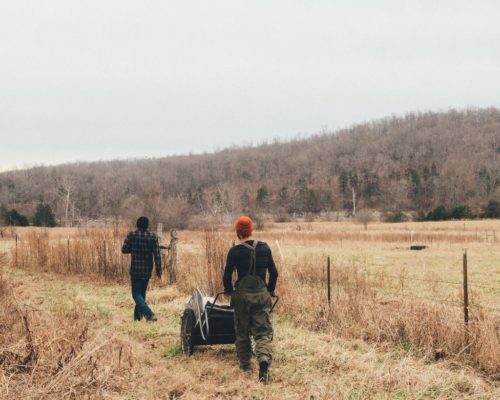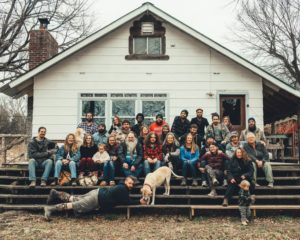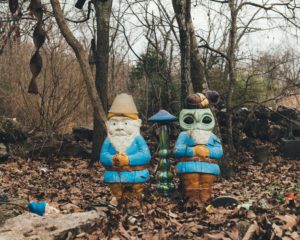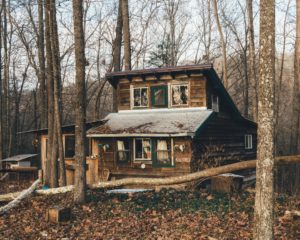
Ransom (a pseudonym) Heath, 42, and Eric Johnson, 36, on their way to feed the pigs at the East Wind intentional community in the Ozarks.
As so-called intentional communities proliferate across the country, a subset of Americans is discovering the value of opting out of contemporary society.
THE EAST WIND COMMUNITY is hidden deep in the Ozarks of southern Missouri, less than 10 miles from the Arkansas border, surrounded by jagged hills and tawny fields. Getting there requires traversing country roads that rise, dip and twist through chicken-wire-fenced farmsteads and grazing pastures cluttered with rusty agricultural equipment until you reach 1,145 acres of largely undeveloped highland forest, where cedar, oak, pine and mulberry create a dense canopy. Beneath that are 27 buildings and structures, including four large dormitories, nine personal shelters, a kitchen and dining facility, an automobile shop, a nut butter manufacturing plant and a cold-storage warehouse, all built over the years by the community since its founding in 1974. Outside, farm animals — six piglets, 50 chickens, several dozen brown-and-white cows —crunch through the carpet of winter leaves.
Nearby, a pair of women make their way down a muddy field, one pushing a wheelbarrow, to a weathered-gray wooden barn where they’ll draw gallons of milk from their dairy cows. A reedy man with a long, sandy mullet presses a chain saw to the base of a tree trunk. People stop each other on the dirt paths, asking about the understaffed forestry program, or recounting anecdotes about going into town to sort through credit card charges. Everyone has somewhere to be, yet no one is hurried. There are no smartphones in sight. The collective feels like a farm, a work exchange and a bustling household rolled into one, with much work to be done but many hands to be lent.
East Wind is what its 72 residents call an intentional community, a modern descendant of the utopian colonies and communes of centuries past where individuals share everything from meals, chores and living space to work, income, domestic responsibilities and the burden of self-governance. The term intentional community dates to the late 1940s, when the Inter-Community Exchange — an organization formed in Yellow Springs, Ohio, in the wake of World War II to help promote peaceful, cooperative living arrangements (in the hope of eradicating war altogether) — changed its name to the Fellowship of Intentional Communities; the founders felt the new title better conveyed the deliberateness with which these groups were assembling. The members of East Wind, for example, range in age from infancy to 76: Some have lived here for more than three decades, but around half of the population is part of a new wave, people in their late 20s and early 30s who joined in the last four years. These newer residents moved to East Wind to wean themselves off fossil fuels, grow their own food, have a greater say in how their society is run and live in less precarious financial circumstances.
According to Sky Blue, the 39-year-old executive director of the Foundation for Intentional Community and a former member of the Virginia-based commune Twin Oaks, which was founded in 1967, the number of intentional communities listed in the FIC’s directory nearly doubled between 2010 and 2016 (the last year the directory was published), to roughly 1,200. Although the number of people living in these communities is hard to pin down — the demographic is often deliberately off the grid — Blue estimates that there are currently around 100,000 individuals residing in them. “There’s an obvious growth trend that you can chart,” he said; millennials “get this intentional community thing more than people in the past.”
THE UNITED STATES HAS been a laboratory for experiments in alternative living since its founding. The English Puritans and Pilgrims who, wishing to escape the oppression and persecution of the Church of England, fled to America in the early 17th century to create smaller societies where they could live according to their faith were followed, notably, by the Transcendentalists in 1830s New England, who sought to distance themselves from the ruthlessness of the Industrial Revolution and instead lead a life driven by Romantic ideals.

Aubrey DeLone, 31, harvests kale from a community garden.
intellectual and leisure pursuits, promoting self-improvement — it attractedsocial reformers and early feminists, theologians and authors (Nathaniel Hawthorne was a founding member). Though it peaked at just 32 people and was officially shuttered in 1847 after being devastated by debt, smallpox and a fire, it became an American model for subsequent utopian projects. Over the following decades, more communities, including the Amana Colonies in Iowa and the Oneida Colony in upstate New York, served as sanctuaries from materialism and modernity. By the early 1900s, though, many of these had collapsed under the weight of financial pressures, ideological strife and tensions between the fantasy of social enlightenment and the realities of manual labor and working-class living conditions.

East Winders in front of REIM, which houses the community’s laundry room and a music studio.

Lawn decorations are popular at some East Wind dormitories.Credit…
Last February, Sumner Nichols, a 29-year-old who grew up in Pennsylvania and moved to East Wind four years ago, invited me to visit the community, which was originally established by a group of men and women who had been living at Twin Oaks and decided they wanted to use the knowledge and experience they accumulated to start their own commune. After amassing a handful of followers during stops in Vermont and Massachusetts, the fledgling group eventually settled in the Ozarks because the land was cheap and adjacent to water. The residents, whose commitment to industry has helped ensure East Wind’s longevity, crafted rope hammocks by hand in partnership with Twin Oaks in the 1970s before launching their own jarred nut-butter business in the early 1980s; their products, which are mainly sold across the Midwest, typically gross between $2 million and $3 million annually. All adult members of East Wind must work 35 hours per week in various capacities, whether cooking, gardening, milling lumber, maintaining infrastructure, looking after the animals or working in the manufacturing plant. Because it’s a relatively modest schedule, residents have enough free time to cultivate personal passions: Nichols practices wildlife photography, while other members produce and record music, study herbal medicine and create ceramics using the community kiln.

One of East Wind’s personal shelters, Gitchigumi.

